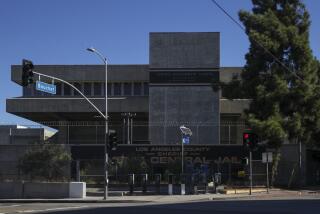Quake Clears Way for Future at St. John’s
- Share via
The Northridge earthquake made a shambles of St. John’s Hospital and Health Center in Santa Monica. Yet to this day, administrators call the quake a blessing in disguise.
Amid cracked walls and broken glass, doctors decided to rebuild their aging white elephant with fewer hospital beds and more outpatient services--an ambitious undertaking they hoped would reflect the changing nature of medicine.
Now the 56-year-old hospital has been promised funding for a plan that doctors believe will fundamentally change the way patients are treated.
The Federal Emergency Management Agency said it will grant St. John’s $133.5 million to help pay for a new hospital. St. John’s is one of four Los Angeles-area hospitals informed this week that they would receive FEMA awards to restore or replace medical facilities damaged in the January 1994 earthquake.
Cedars-Sinai Medical Center in West Los Angeles expects to receive $30.8 million to replace two medical buildings that housed ambulatory care, outpatient surgery, researchers and other services.
The other two facilities--UCLA Medical Center and County-USC Medical Center--have yet to determine how they will spend their grants of $294.4 million and $409.9 million, respectively.
For now, it is St. John’s that has developed the most comprehensive plan. The hospital intends to spend $250 million to rebuild in the parking lots and grassy areas around its existing complex, which will be torn down when the work is completed in 2001. Hospital officials plan to raise the additional funds through private sources. St. John’s is a private, nonprofit hospital operated by the Sisters of Charity of Leavenworth, a Kansas-based Roman Catholic order.
The new hospital, at 520,000 square feet, will be somewhat smaller than its predecessor, and the number of beds will be reduced from 250 to 150.
The hospital will emphasize procedures that allow patients to be treated without prolonged hospital stays, administrators say. For example, doctors are already using the laparoscope--a long, thin instrument that makes a tiny incision--to remove diseased gallbladders and other organs on an outpatient basis.
“The image of the hospital where people spend days in bed after surgery is going to be a thing of the past,” said Bruce Lamoureux, the hospital’s chief operating officer.
Architects of the new hospital envision a complex where services are easily accessible. CT scans, X-rays, emergency care and other services will be clustered together so that patients don’t have to traverse the hospital’s existing maze of corridors.
Technology also will play a major role in the new design. Patients will have access to their own records on computers at a medical library and in hospital rooms. And they will be able to consult with doctors from home on television via fiber optic cables that flash X-rays and other information across the screen, doctors say.
Ultimately, doctors hope to rid the hospital of paperwork and computerize all records.
“You don’t need big monolithic hospitals anymore,” said Dr. Dennis Sarti, director of radiology at St. John’s and head of a steering committee that is planning the coming technological changes. “You need small, highly flexible hospitals with a large outpatient emphasis.”
The plans at St. John’s mirror reforms being undertaken at hospitals across the country.
Managed care proposals have forced medical facilities to rein in costs, partly by admitting fewer people for inpatient care. At the same time, advances in medical technology are leaving more and more hospital beds vacant.
Experts say that St. John’s is uniquely positioned to respond to this changing medical world because it is ridding itself of the single most burdensome element--the facility itself.
“St. John’s will have the benefit of being able to build this new model from the ground up,” said Jim Lott, a spokesman for the Health Care Assn. of Southern California.
Like many other hospitals, St. John’s had planned to make such changes gradually. The earthquake moved up the timeline.
The temblor caused an estimated $32 million in damage. The hospital’s north wing--home to 185 beds as well as neonatal intensive care and obstetrics--was devastated and had to be demolished. The main building and the south wing were damaged and had to be repaired. Hundreds of patients had to be evacuated.
A few days after the quake, hospital leaders met and decided that simply remodeling would be shortsighted.
“Now we have a wonderful opportunity to build a prototype health center for the 21st century,” said Sister Marie Madeleine Shonka, St. John’s president and chief executive officer.
More to Read
Sign up for Essential California
The most important California stories and recommendations in your inbox every morning.
You may occasionally receive promotional content from the Los Angeles Times.













